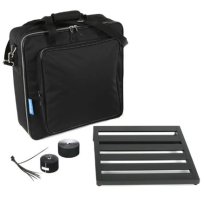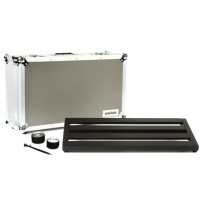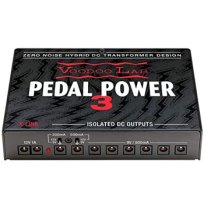This article and its corresponding YouTube video (shot by Liam Killen) are the first of a 10-episode series focused on the best pedals for synths.
In this inaugural segment, we decided to provide comprehensive guidance on the optimal and most effective method for integrating FX pedals with your synth setup. The following episodes will focus on the best pedals for synth, organized by type of effect.
Guitar Pedals with Synths: Why?
Combining guitar pedals with synthesizers can be an inspiring musical journey rich with sonic possibilities. In fact, there’s a burgeoning market that specifically caters to this fusion. The transition from guitar to synth is a well-trodden path, making it a seamless progression for guitarists interested in electronic sounds.
While it’s true that certain pedals can be on the pricey side, within the realm of synthesis and FX, they often present some of the most cost-effective and portable modular options. Their modular nature allows for easy swapping and experimentation.
Check out this section of Liam’s video where he showcases a few types of pedals and what they can do to a Novation Circuit Rhythm:
—
—
How should I set up and power my pedals?
Pedalboard
More often than not, synth players who use pedals don’t bother organizing them up on a pedalboard, but opting for a pedalboard significantly streamlines the setup and teardown. Modern pedalboard builders are now providing designs with a more vertical layout, such as the Pedaltrain XD-18 used in this demo. This vertical orientation better suits synth players who prefer placing pedals next to their synths, in contrast to the horizontal format favored by guitarists who position them on the floor.
Pedaltrain offers a wide range of boards available in many different sizes and prices, here are some popular options:
Browse through all the Pedaltrain boards options on Sweetwater.com
Power Supply Unit
In our video, we showcase seven units securely fastened to the board using Velcro, providing the flexibility to easily swap them out for alternative pedals. Typically, the power supply unit (PSU) is Velcroed to the underside of the board, maximizing space for additional pedals. The entire setup, complete with the XD-18 case, is highly portable.
When it comes to powering the pedals, you have several options. While batteries can be used, a preferable approach is using the individual adapters that come with the pedals. An even more efficient method, as demonstrated here with the Voodoo Lab Pedal Power 3, is utilizing an all-in-one PSU unit. The Pedal Power 3 offers isolated power outputs, ensuring a noise-free performance and eliminating concerns related to ground noise. This approach simplifies the setup by reducing cable and plug clutter in your rig, making your setup less complicated and hassle-free.
There are several models of PSUs you can choose from Voodoo Lab depending on your needs. Some are able to power also 12v pedals.
Browse through all the Voodoo Lab PSU options on Sweetwater.com
Audio Connections
You will need several 1/4″ patch cables to connect all the pedals. Some can be as short as 8″, some will need to be a little longer to connect pedals on different rows.
The ins and outs on guitar pedals are set up from right to left (when you look at them from the front) so you’ll normally place your first pedal in the chain on the top or bottom row all the way to the right, then proceed to the left, and then, at the end of the row, use a longer cable to connect the last pedal on the first row to the first one on the next row. All modern pedalboards have openings that let you tuck them under the board, so that the surface where the pedals sit remains relatively uncluttered.
The tidier you keep your cabling, the more you minimize potential for breaking or accidentally disconnecting them, events that have a very disruptive effect on performances and inspiration.
Midi Connections
Many modern pedals are Midi compatible, and synching them to your synth or DAW/Sequencer allows for automation and remote control. Synth users should be familiar with how Midi works and this is not the place to tackle that topic. It’s just worth mentioning that if you have more than one Midi pedal on your board you may want to purchase a Midi Interface, because pedals don’t have the Midi Thru connection found on most synths that allows to connect several of them in series.
Needles to say, Midi will add an extra layer of cable “mess” to your setup, but one that may be worth the hassle!
—
—
Stereo Vs. Mono
When considering the instrument you’re using with your FX pedals, it’s important to decide whether a stereo or mono signal is preferred. Even though mono synths can still produce rich sounds, utilizing stereo FX can elevate them significantly. The character of a classic or modern synth sound can be greatly influenced by the FX pedals it’s routed through.
Regarding the choice between mono and stereo, it’s important to examine how your synth’s stereo is split, as each synth setup is unique. Ultimately, finding the right balance involves experimentation to discover what appeals to your taste.
Effects Pedal Order
Mono > Stereo
In terms of pedal ordering, starting with mono pedals at the beginning of the chain and placing stereo pedals at the end, without reverting to mono, is a logical approach. In our setup, the Eventide Tricerachorus, which has a mono in and stereo out, acts as the transition point where the signal shifts from mono to stereo, maintaining a stereo configuration until the end, since the following pedals have stereo in and outs.
This arrangement provides a streamlined organization, allowing for easy bypass of the mono FX, all neatly positioned at the start of the chain.
Suggested Order by Type of Effect
In the setup used in the videos we haven’t included any (1.) distortion or fuzz pedals on our board; typically, you’d position these at the start of your signal chain.
Following that, you’d integrate other generally mono like (2.) filters, EQs and tremolos , followed by (3). modulation and time-based effects such as (4.) reverb and delay, which can be either mono or stereo – although modulation applied to delay and reverb is a growing trend. As previously recommended, keep all the stereo ones at the end of the chain.
Having mentioned this, there are no strict rules regarding effect order, aside from what your ears guide you towards.
However, maintaining consistency and sticking with an arrangement that resonates with you, rather than frequently reorganizing your board, simplifies the process. Inspiration tends to thrive in an environment of simplicity and efficiency.
More Complex Routing
In the video linked to this episode we kept things simple by applying the effect chain to a master track (i.e. all effect are connected in series, one after the other). However, for those interested in more complex configurations, there are a few options to consider.
An easy one would be to connect different effects pedals to different synths: for example, a chorus sounds great on your bass, reverb is always good on drums and a creative delay can do magic to add texture to your synth sounds.
However, switching configuration on the fly, so that different effects, or different chains of effects are applied to different audio sources at the touch of a button, is possible via a control switcher like the Voodoo Lab PX-8 PLUS (pictured below), which provides up to 8 ins/out each linked to a footswitch.

Voodoo Lab PX-8 Plus Pedal Switcher | [Click for video]
Level-Related Issues
When you have a chain of multiple effects, it’s common to encounter a few challenges related to level.
Distortion Between Pedals
On of them is unwanted distortion due to excessive output, even when using line-level compatible pedals. A simple remedy is to start with a low synth level initially. If it sounds satisfactory, gradually increase the volume into the pedal.
Distortion or fuzz pedals are particularly problematic because they tend to generate internal saturation, yet their output is often designed to deliver high volume suitable for a guitar amp, built to handle it. Exercise caution with the level knobs on on these pedals in the chain to avoid overloading the input of the next pedal.
Volume Consistency
Maintaining a consistent volume level is crucial when you have multiple effects connected in series, each with its own volume control. This ensures a smooth transition when you engage them, preventing sudden drops or boosts in volume (unless intentional, as with boost and overdrive pedals).
Achieving a steady volume across the effects you’ve activated requires a delicate balance, which may take some time to perfect. However, adjusting levels on the fly during a performance is always an option. It’s important to note that certain effects can subtly alter your synth’s prominence in the mix due to phase shifts or changes in frequencies.
Ultimately, relying on your ears is the most effective way to address and correct these variations.
Pedals Used in This Video
- Boss SL-2 Slicer
- Red Panda Particle V2
- Meris LVX
- Eventide Tricerachorus
- Eventide H90
- Strymon NightSky
– Article by Liam Killen and Paolo De Gregorio
—





























1 comment
RUDE TECH Effects says:
Sep 28, 2023
Customers email me all the time saying they are using my pedals with synth. If there’s EVER an issue, it’s always with keeping the incoming volume on the pedals in your chain consistent. Bypass everything, listen to the volume, then kick on each pedal one at a time to check. Use the last pedal in the chain as the preamp volume.